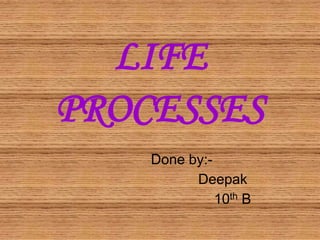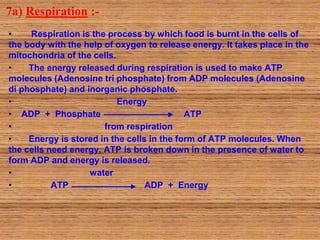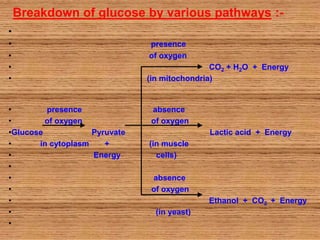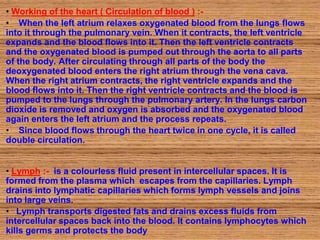Deepak project science
- 1. LIFE PROCESSES Done by:- Deepak 10th B
- 2. 1) Criteria to decide whether something is alive :- • The most important criteria to decide whether something is alive is movement. All living things move without the help of any external help. Some movements are easily visible like the movements of body parts. Some movements are not easily visible like molecular movements. The molecular movements in cells and tissues is necessary for all life processes.
- 3. 2) Life processes :- • Life processes are the basic processes in living organisms which are necessary for maintaining their life. The basic life processes are – nutrition, respiration, transportation, and excretion. • i) Nutrition :– is the process of taking food by an organism and its utilization by the body for life processes. • ii) Respiration :– is the process by which food is burnt in the cells of the body with the help of oxygen to release energy. •iii) Transportation :– is the process by which food, oxygen, water, waste products are carried from one part of the body to the other, •iv) Excretion :- is the process by which waste products are removed from the body.
- 4. 3) Nutrition :- • Nutrition is the process of taking food by an organism and its utilisation by the body to build the body, for growth, to repair the damaged parts of the body and for energy. • Life on earth depends on carbon based molecules and most of the food are also carbon based molecules. The outside raw materials used by living organisms are food, water and air. •a) Modes of nutrition :- There are two main modes of nutrition. They are autotrophic nutrition and heterotrophic nutrition. •i) Autotrophic nutrition :- is nutrition in which organisms prepare their own food from simple inorganic substances like carbon dioxide and water in the presence of sunlight and chlorophyll. • Eg :- all green plants and some bacteria. •ii) Heterotrophic nutrition :- is nutrition in which organisms get their food directly or indirectly from plants. • Eg :- all animals fungi and some bacteria. •b) Types of heterotrophic nutrition :- There are three main types of heterotrophic nutrition. They are saprophytic, parasitic and holozoic nutritions.
- 5. •i) Saprohytic nutrition :- is nutrition in which organisms get their food from dead and decaying organisms. They break down the food material outside their body and then absorbs it. Eg :- mushroom, bread mould, yeast, some bacteria etc. • ii) Parasitic nutrition :- is nutrition in which organisms get their food from living organisms (host) without killing them. Eg :- cuscuta, orchids, ticks, lice, leeches, round worm, tape worm, plasmodium etc. •iii) Holozoic nutrition :- is nutrition in which organisms take food directly and then digests and absorbs it. Eg :- amoeba, paramaecium, birds, fishes, humans etc.
- 6. 4) Nutrition in plants :- • Photosynthesis :- is the process by which plants prepare food by using carbon dioxide and water in the presence of sunlight and chlorophyll. The food prepared is carbohydrate which is stored in the form of starch. Oxygen is released in this process. • Equation of photosynthesis :- • Sunlight • 6CO2 + 12H2O C6H12O6 + 6H2O + 6O2 • Chlorophyll • Process of photosynthesis :- • Photosynthesis takes place in three main steps. They are :- • i) Absorption of light energy by chlorophyll. • ii) Conversion of light energy into chemical energy and splitting up of • water molecules into hydrogen and oxygen. •iii) Reduction of carbon dioxide by hydrogen to form carbohydrates. •
- 8. •Chlorophyll :- are the green pigments present in the leaves. If we observe a cross section of a leaf under a microscope, we can see cells containing green dot like structures called chloroplasts which contain chlorophyll.
- 9. •Stomata :- are tiny pores present in the leaves through which exchange of gases takes place. Each stoma has a pair of guard cells which controls the opening and closing of the stomatal pore. When water enters the guard cells, it swells and the pore opens and when the guard cells lose water, it shrinks and the pore closes.
- 10. 6) Nutrition in animals :- •a) Nutrition in amoeba :- • Amoeba is a unicellular animal living in water. It takes in food by forming finger like projections called pseudopodia and forms a food vacuole. Inside the food vacuole the food is digested and absorbed. The undigested food is then sent out through the surface of the cell.
- 11. b) Nutrition in Human beings :- • Nutrition in human beings takes place in the digestive system. It consists of the alimentary canal and glands which produce enzymes which breaks down food into smaller molecules. • The main organs of the digestive system are mouth, oesophagus, stomach, small intestine, large intestine, and anus. The main glands are salivary glands, gastric glands, liver, pancreas and intestinal glands.
- 13. • In the mouth :- the food is broken down into smaller particles by the teeth and mixed with saliva from the salivary glands. Saliva contains the enzyme salivary amylase which converts starch into sugar. Then the food passes through the oesophagus into the stomach. • In the stomach :- the gastric glands produce gastric juice which contains the enzyme pepsin, hydrochloric acid and mucous. Pepsin breaks down proteins. Hydrochloric acid makes the medium acidic and helps in the action of pepsin. Mucous protects the walls of the stomach from the action of the acid. Then the food passes into the small intestine. • In the upper part of the small intestine called duodenum :- the food is mixed with bile from liver and pancreatic juice from the pancreas. Bile breaks down fats into smaller globules. Pancreatic juice contains the enzymes trypsin and lipase. Trypsin breaks down proteins and lipase breaks down fats. • In the small intestine :- the glands the walls of the small intestine produces intestinal juice. The enzymes of the intestinal juice coverts carbohydrates into glucose, fats into fatty acids and glycerol and proteins into amino acids. The walls of the small intestine has several finger like projections called villi having blood vessels. It helps to increase the surface area for the absorption of digested food. The digested food is absorbed by the blood and transported to all cells in the body. Then the undigested food passes into the large intestine. • In the large intestine :- water is absorbed and the waste material is removed through the anus. •
- 14. 7a) Respiration :- • Respiration is the process by which food is burnt in the cells of the body with the help of oxygen to release energy. It takes place in the mitochondria of the cells. • The energy released during respiration is used to make ATP molecules (Adenosine tri phosphate) from ADP molecules (Adenosine di phosphate) and inorganic phosphate. • Energy • ADP + Phosphate ATP • from respiration • Energy is stored in the cells in the form of ATP molecules. When the cells need energy, ATP is broken down in the presence of water to form ADP and energy is released. • water • ATP ADP + Energy
- 15. b) Types of respiration :- • There are two main types of respiration. They are aerobic and anaerobic respiration. •i) Aerobic respiration :- takes place in the presence of oxygen. It produces more energy. The end products are carbon dioxide, water and energy. It takes place in most organisms. • In aerobic respiration glucose is converted into pyruvate in the cytoplasm in the presence of oxygen and then in the presence of oxygen, pyruvate is converted into carbon dioxide, water and energy in the mitochondria. • presence of oxygen presence of oxygen •Glucose Pyruvate CO 2 + H2O + Energy • in cytoplasm in mitochondria •ii) Anaerobic respiration :- takes place in the absence of oxygen. It produces less energy. The end products are lactic acid or ethanol, carbon dioxide, and energy. It takes place in muscle cells and yeast. • In anaerobic respiration in muscle cells, glucose is converted into pyruvate and in the absence of oxygen pyruvate is converted into lactic acid and energy. • presence of oxygen absence of oxygen •Glucose Pyruvate Lactic acid + Energy • in cytoplasm in muscle cells • In anaerobic respiration in yeast, glucose is converted into pyruvate and in the absence of oxygen pyruvate is converted into ethanol, carbondioxide and energy. This process is called fermentation. • presence of oxygen absence of oxygen •Glucose Pyruvate Ethanol + CO 2 + Energy • in cytoplasm in yeast
- 16. Breakdown of glucose by various pathways :- • • presence • of oxygen • CO2 + H2O + Energy • (in mitochondria) • presence absence • of oxygen of oxygen •Glucose Pyruvate Lactic acid + Energy • in cytoplasm + (in muscle • Energy cells) • • absence • of oxygen • Ethanol + CO2 + Energy • (in yeast) •
- 17. b) Respiration in Humans :- • The main organs of the respiratory system are nostrils, nasal cavity, pharynx, larynx, trachea, bronchi, bronchioles, lungs and diaphragm.
- 18. • Air enter through the nostrils. The hairs and mucous traps the dust particles. It then passes through the phraynx, larynx, trachea, bronchi and enters the lungs. The trachea has rings of cartilage which prevents it from collapsing when there is no air in the trachea. The bronchi divides into smaller tubes called bronchioles which ends in tiny air sacs called alveoli. The alveoli is supplied with blood vessels through which exchange of gases takes place. The alveoli helps to increase the surface area for the exchange of gases.
- 19. Mecahanism of breathing :- • When we breathe in air, the muscles of the diaphragm contracts and moves downward and the chest cavity expands and air enters into the lungs. • When we breathe out air, the muscles of the diaphragm relaxes and moves upward and the chest cavity contracts and air goes out of the lungs.
- 20. 8) Transportation :- •a) Transportation in Human beings :- • The main transport system in human beings is the circulatory •system. It consists of blood, arteries, veins capillaries and heart. • i) Blood :- transports food, oxygen and waste products. It consists of •plasma, red blood cells (RBC), white blood cells (WBC) and platelets. •Plasma transports food, water, carbondioxide, nitrogenous waste etc. •Red blood cells transports oxygen. White blood cells kills harmful •microbes and protects the body. Platelets help in clotting of blood and •prevents loss of blood during injury. • ii) Arteries :- carry pure blood from the heart to all parts of the body. •They are thick walled and do not have valves. •iii) Veins :- carry impure blood from all parts of the body to the heart. •They are thin walled and have valves. •iv) Capillaries :- are very narrow blood vessels which connects •arteries and veins together. The exchange of food, water, oxygen, •carbon dioxide etc. between the blood and cells take place through •the capillaries.
- 21. •v) Heart :- is a muscular organ which pumps blood to all parts of the body. It has four chambers. The upper chambers are called atria and the lower chambers are called ventricles. Since the ventricles pump blood to the different organs its walls are thicker than the atria. The right and left chambers are separated by a septum. It prevents the mixing of oxygenated and deoxygenated blood The atria and ventricles have valves between them to prevent blood flowing backward. xxxx vein xxxxxxxx artery xxxxx heart
- 22. Working of the heart (Circulation of blood) :-
- 23. • Working of the heart ( Circulation of blood ) :- • When the left atrium relaxes oxygenated blood from the lungs flows into it through the pulmonary vein. When it contracts, the left ventricle expands and the blood flows into it. Then the left ventricle contracts and the oxygenated blood is pumped out through the aorta to all parts of the body. After circulating through all parts of the body the deoxygenated blood enters the right atrium through the vena cava. When the right atrium contracts, the right ventricle expands and the blood flows into it. Then the right ventricle contracts and the blood is pumped to the lungs through the pulmonary artery. In the lungs carbon dioxide is removed and oxygen is absorbed and the oxygenated blood again enters the left atrium and the process repeats. • Since blood flows through the heart twice in one cycle, it is called double circulation. • Lymph :- is a colourless fluid present in intercellular spaces. It is formed from the plasma which escapes from the capillaries. Lymph drains into lymphatic capillaries which forms lymph vessels and joins into large veins. • Lymph transports digested fats and drains excess fluids from intercellular spaces back into the blood. It contains lymphocytes which kills germs and protects the body
- 24. Hearts of mammals, birds, amphibians, reptiles, and fishes :- •i) The heart in mammals :- and birds have four chambers and the right and left sides of the heart is separated by a septum. This prevents mixing of oxygenated and deoxygenated blood and provides efficient supply of oxygen. This is necessary because they need more energy to maintain their body temperature. •ii) The heart in amphibians and reptiles :- have three chambers and allows some mixing of oxygenated and deoxygenated blood because the do not use energy to maintain their body temperature. Their body temperature is the same as the temperature of the surroundings. •iii) The heart in fishes :- have only two chambers and blood is oxygenated in the gills. •
- 25. Transportation in plants :- • In plants, transportation of materials like food, water and minerals takes place through conducting tissues called xylem and phloem. •i) Xylem :- transports water and minerals from the roots to all parts of the plant. It consists of xylem vessels and tracheids. Water and minerals enter the roots by diffusion. Then due to transpiration, the suction force helps in the upward movement of water an minerals.
- 26. •ii) Phloem :- transports food from the leaves to the other parts of the plant. This process is called translocation. The phloem consists of sieve tubes and companion cells. Food from the leaves is transferred to the xylem by the energy of ATP molecules. Due to osmotic pressure water enters the phloem and helps in the transport of food.
- 27. 9) Excretion :- • Excretion is the process by which the waste products produced during metabolic activities is removed from the body. • In unicellular organism the waste products are removed from the cells into the surroundings by diffusion. • In multicellular organisms the waste prducts are removed through specialised organs.
- 28. a) Excretion in Human beings :- • The excretory system consists of a pair of kidneys , a pair of ureters, urinary bladder and urethra. Each kidney has a number of excretory units called nephrons.
- 29. •Nephron :- • Each nephron has a cup like structure called Bowman’s capsule containing a bundle of capillaries called glomerulus. The Bowman’s capsule leads into a tubular structure which joins into a collecting duct. The renal artery brings the nitrogenous waste like ammonia, urea, uric acid (urine) along with excess water, salts etc. into the nephron. It filters the nitrogenous waste, water and salts which passes through the tubular structure into the collecting duct. The waste then passes through the ureters into the urinary bladder and is then sent out through the urethra •as urine. • The useful products like amino acids, glucose, salts etc. are reabsorbed by the capillaries around the tubular structure and goes into the real vein. •b) Excretion in plants :- • In plants the gaseous waste products produced during respiration (CO2) and photosynthesis (O2) are removed through the stomata. Excess water is removed through the stomata. This process is called transpiration. • Some waste products are stored in the leaves and removed when the leaves dry and fall off. Some waste products are stored in vacuoles. Some waste products like gums and resins are stored in the old xylem cells. Some waste products are removed through the roots.
- 31. Thank you






























